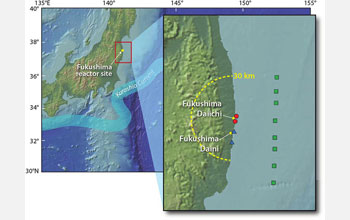New study analyzes radioactivity from facility in first months after accident
 Credit and Larger Version |
December 9, 2011
With current news of additional radioactive leaks from the Fukushima nuclear power plants, the impact on the ocean of releases of radioactivity from the plants remains unclear.
But a new study by U.S. and Japanese researchers analyzes the levels of radioactivity discharged in the first four months after the accident.
It draws some basic conclusions about the history of contaminant releases to the ocean.
The study was conducted by Woods Hole Oceanographic Institution chemist Ken Buesseler and two colleagues based in Japan, Michio Aoyama of the Meteorological Research Institute and Masao Fukasawa of the Japan Agency for Marine-Earth Science and Technology.
They report that discharges from the Fukushima Dai-Ichi nuclear power plants peaked one month after the March 11 earthquake and tsunami that precipitated the nuclear accident, and continued through at least July.
Their study finds that the levels of radioactivity, while high, are not a direct threat to humans or marine life, but cautions that the effect of accumulated radionuclides in marine sediments is poorly known.
The release of radioactivity from Fukushima--both as atmospheric fallout and direct discharges to the ocean--represents the largest accidental release of radiation to the ocean in history.
No comments:
Post a Comment